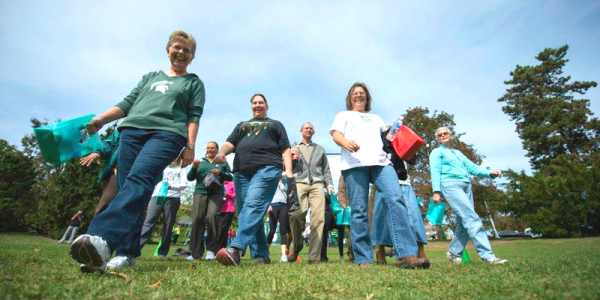Employee Athletes Get The Job Done For MSU
.jpg)
Regardless of your role and the setting that you work in, it’s important to take steps to protect yourself on the job.
MSU employees work hard. Perhaps nobody knows this better than the Infrastructure, Planning and Facilities (IPF) field employees that keep campus running. Just consider the hundreds of MSU staffers that spend the workday on their feet- shoveling and hammering, twisting and bending, lifting and carrying- all to get the job done.
Regardless of your role and the setting that you work in, it’s important to take steps to protect yourself on the job. For field workers, that may mean taking extra precautions to avoid Musculoskeletal Disorders (MSD). MSDs are any number of injuries and disorders that impact the body’s musculoskeletal system, and in turn your ability to move. Sprains and strains, tendinitis, and carpal tunnel are just a few examples of MSD. They typically occur as a result of excessive stress being placed on the muscles, tendons, ligaments and nerves. Risk of suffering an MSD increases with movements that involve high repetition, high force, awkward postures, and hand-arm vibration (typically from power tools). Fatigue can also lead to increased risk of an MSD.
Field employees are at a particularly high risk for workplace MSDs because their roles may require frequent movement, lots of muscle, and often being in difficult or awkward positions (stooping, working overhead, etc.). In the construction trade, it’s estimated that 30% of the workforce will deal with an MSD. If you are a field employee and have a physically demanding job, this article is designed to get you thinking about your physical wellbeing as a cog in the wheel that makes MSU turn.
In a meeting a few months ago, an IPF supervisor told me that he considers IPF staffers employee athletes. This phrase has stuck with me because it does such a great job capturing the physical nature of the work that they do. We know that athletes warm up before a game both to prevent injuries, and to prime their bodies to perform at the highest level. If you think about yourself as an employee athlete, the same ideas apply. Completing a warmup before starting the job can help prevent injuries, which is a major benefit. At the same time, a warmup routine can help you get into a good physical and mental state to perform the task at hand. Taking a few minutes to warm up and stretch before starting your workday is a great way to reset, clear your mind, take a few deep breaths and loosen your body up for the day’s challenges.
Click Here for a Stretch and Flex Jobsite Warmup Routine
Even the best athletes get injured sometimes, and employee athletes are no exception. Back injuries are one of the most common injuries that field employees encounter, accounting for 39% of all work-related MSDs in 2016. To get a better sense of how to protect against back injuries, let’s first examine the anatomy that is at work:
The human torso is supported by a system of 24 bones that align vertically to form the spine. The spine provides the structure necessary for us to maintain an upright posture, while also protecting the spinal cord. Between each of those 24 vertebrae, there are disks that act little hydraulic shock absorbers. These disks are made of a tough outer ring and a softer, gelatinous inner structure called the nucleus pulposus. Water and proteins flow in and out of the disks, keeping them lubricated and able to absorb impact.
When the spine is not under load (when you’re sleeping), the disks refill. This is why your back may feel stiff in the morning, because your disks are ‘pumped’ full of fluid. When the disks are compressed (as you begin moving), some fluid is pushed out- allowing your back to ‘loosen up’. This is all normal. MSDs become a concern when risk factors on the job begin to add up. Those risk factors are familiar ones, like repetitive motion, flexing and twisting of the spine, awkward work positions, or having to use high force on a job. If not mitigated, these movements can ultimately lead to injury. You’ve probably heard of a herniated disk. This MSD occurs when excessive tension causes a disk to deform and start to protrude outside of its normal range. As a result, the disk may push on a nerve. This can be extremely painful and may require surgery to repair.
A dehydrated fibrotic disk is another back-related MSD. This condition is caused by degraded tissue in the disk that can no longer properly rehydrate. Because the disk can’t absorb impact like it should, you’re likely to experience pain from the vertebrae pushing against one another. While back injuries are a major concern for the workforce, there are steps you can take to lower your risk.
A proactive, safety-minded approach is the most effective strategy for protecting yourself from injury, and proper lifting technique is a great place to start. When lifting a heavy item, plant the feet firmly to establish a solid base. Bend at the knees and use two hands to get a good grip on the load. When ready, lift from the legs while tightening the core muscles. Keep the chest up, shoulders back, and draw power from the legs and hips. Twisting, jerking, and rounding the back should be avoided. Once you’ve lifted the load, keep it close to your body in the ‘power zone’. This zone is between the thigh and chest, similar to the strike zone in baseball. Keeping the load in this zone maximizes mechanical advantage, allowing you to carry the most weight with the least amount of effort. Poor posture was the most commonly observed risk factor when looking at lower-back injuries.
Beyond good posture, there are several steps you and your unit can take to protect against MSDs of the back. Utilize these tips on the jobsite, and encourage colleagues and supervisors to follow them as well. Creating a culture of workplace safety is everyone’s responsibility.
Tips for protecting your back:
- Wait for help if it’s a two-person lift. If in doubt, do not try to lift it solo. A lifetime of back pain is not worth it!
- Keep a good neutral posture by maintaining the natural curves of the spine.
- Cut down on carrying by having materials delivered close to where they will be used.
- Raise your work to waist level where possible.
- Take rest breaks. When you are tired, you can get injured more easily.
- Use carts, dollies, forklifts, and hoists to move materials—not your back.
- Use carrying tools with handles to get a grip on odd-shaped loads.
- When carrying materials, hold the load close to your body in the ‘power zone’.
- Try not to twist the back when lifting and lowering materials. Turn your whole body instead.
- Lift and lower materials in a smooth, steady manner. Do not jerk.
- Don’t rely on a back brace to protect you, instead lift with good technique.
Want to learn more about safety on the job? Join us at the IPF Safety Rodeo on June 24 at the MSU Pavilion, or visit the IPF Safety and Compliance department.
Related Articles

Work a Desk Job? Watch Your Back: How to avoid pain and set yourself up for success
If you spend lots of time sitting at work, take steps to protect yourself from pain and discomfort with these practical tips

October is Sustainability Month - Celebrate with the MSU Sustainability Walk Series
MSU Sustainability and Health4U are teaming up! Get active and learn more about sustainability initiatives at MSU with this weekly walking series. Walks will take place on Thursdays from 12:00p - 12:50p at various locations on campus.
.jpg)
Embracing Incidental Activity
Lots of people struggle to find time for exercise, and that's normal. By choosing to embrace the movement demands of our everyday lives, we can become more active and improve overall health.

Fitting in Fitness
With a little planning and a shift in perspective, you may find that improved health is closer than you thought. We make the case for the lunchtime workout





